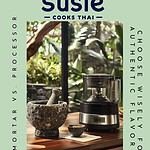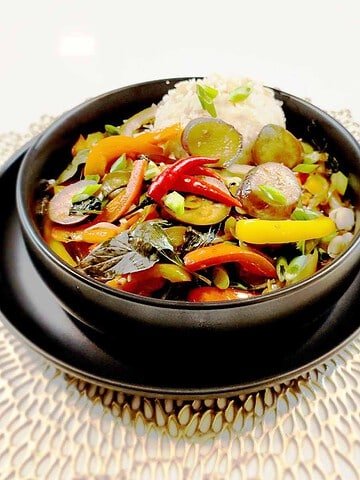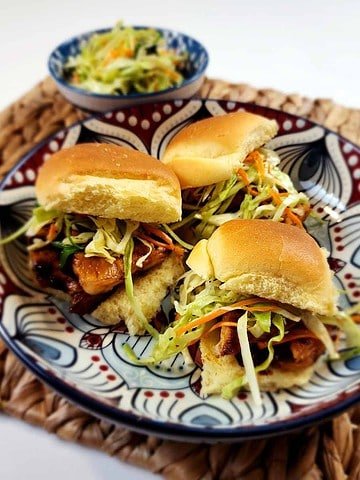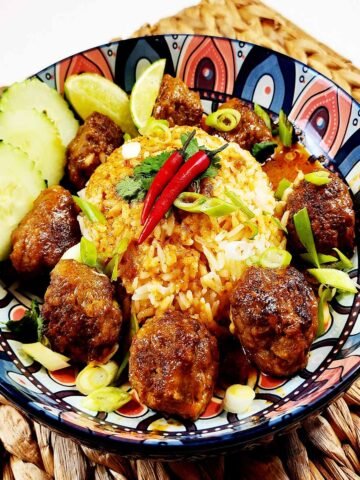
The choice between traditional methods and modern conveniences often arises in Thai cuisine when preparing ingredients. One of the most significant debates revolves around using a mortar, pestle, or food processor. Both tools have their strengths and are integral to achieving authentic flavors, but each offers a distinct approach to food preparation. Here's a comprehensive comparison to help you choose the right tool for your kitchen:
The Traditional Charm of Mortar and Pestle
1. Authenticity and Flavor:
The mortar and pestle, known in Thai as "Kruk" (ครก), have been essential in Thai kitchens for centuries. They are revered for their ability to release essential oils and aromas from herbs and spices, which enhances the depth of flavors in dishes like green curry paste or Som Tum (green papaya salad).
2. Control and Texture:
Using a mortar and pestle allows for precise control over the Texture of ingredients. Thai cooks appreciate the ability to pound ingredients to just the right consistency, whether creating a coarse blend for Larb (spicy minced meat salad) or a smooth paste for Nam Prik (Thai chili paste).
3. Cultural Significance:
Beyond functionality, the mortar and pestle hold a deep cultural significance in Thai culinary traditions. The rhythmic pounding and grinding are not just about preparing food but also embody a connection to Heritage and cooking rituals, fostering a sense of cultural connection and respect for tradition.
Modern Efficiency of the Food Processor
1. Time and Convenience:
Food processors offer unparalleled efficiency, significantly reducing preparation time. They excel at quickly chopping, slicing, and blending ingredients, making them ideal for busy kitchens or when preparing large batches of dishes.
2. Consistency and Volume:
For recipes that require uniformity in Texture, such as Massaman curry or Pad Thai sauce, a food processor ensures consistent results every time. It can handle larger volumes of ingredients without compromising on quality.
3. Versatility:
Beyond Thai cuisine, food processors are versatile tools that can tackle a wide range of culinary tasks, from kneading dough to making smoothies. This versatility empowers home cooks and culinary enthusiasts, making them a staple in many modern kitchens.
Choosing the Right Tool for Your Kitchen
1. Tradition vs. Convenience:
When deciding between a mortar, pestle, and food processor, consider the balance between tradition and Convenience. If authenticity and the preparation ritual are essential to you, a mortar and pestle may be the preferred choice. However, a food processor could better suit your needs if efficiency and versatility are priorities.
2. Ingredient and Dish Specificity:
For instance, dishes that require a coarse texture or delicate handling, such as Larb, often shine with a mortar and pestle. On the other hand, complex sauces and large-scale preparations, like Massaman curry, lean towards the food processor.
3. Personal Preference and Experimentation:
Ultimately, the choice between a mortar and pestle and a food processor can also come down to personal preference and experimentation. This encourages home cooks and culinary enthusiasts to explore and experiment, as many Thai chefs combine both tools in their kitchens, using each where it excels to achieve the best results.
Conclusion
In conclusion, the mortar, pestle, and food processor play integral roles in Thai cuisine, each offering unique benefits that contribute to the rich flavors. Whether you opt for tradition or modernity, the key is to embrace the tool that aligns with your cooking style and enhances your culinary journey in exploring Thai cuisine.
Additional Considerations
1. Maintenance and Durability:
Mortar and pestles are typically easier to clean and maintain than food processors, which may have more parts and electronic components requiring careful handling.
2. Environmental Impact:
Traditional tools like mortar and pestles have a lower environmental impact, as they are usually made from natural materials and do not require electricity.
3. Learning Curve:
Using a mortar and pestle may have a steeper learning curve than a food processor, which can be more intuitive for beginners.
4. Cultural Heritage:
Embracing traditional tools like the mortar and pestle supports the preservation of cultural Heritage and culinary traditions.
Ultimately, both tools have their place in the kitchen, and the choice between them depends on your specific needs, preferences, and the dishes you love to create. Whether you cherish the rhythmic pounding of spices in a mortar or appreciate the efficiency of a food processor, both can help you achieve delicious and authentic Thai flavors at home.






Leave a Reply